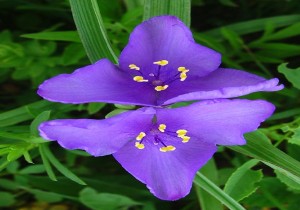The Spiderwort – plants with many weeks of attractive bloom, and requiring little or no care are a boon to the busy gardener.
The common spiderwort comes into bloom in late May or early June and, with some varieties, continuing until August or September. This perennial plant is commonly considered an invasive weed.
Known botanically as Tradescantia virginiana, this beautiful, native perennial, found growing along roadsides and at the edge of wooded areas, comes in colors ranging through white, sky blue, rosy red, mauve, to deep purple- as well as in the delightful blue-purple of its native form.
Locally, common spiderwort may sometimes be called widow’s tears or snake-grass.
Very Hardy Plant

Common spiderwort is a very hardy plant growing to two feet in height, with long, ribbon-like leaves clasping an upright stalk and with flowers produced in clusters at the ends. It is found growing naturally from South Dakota through eastern Kansas and Arkansas, then east to New York and Virginia.
It often escapes from cultivation and becomes naturalized far beyond its native range.
The individual flowers, one to two inches across, consist of three petals and six stamens. The rather prominent stamens are supported by feathery stalks or filaments, from which the common name, spiderwort, is derived.
In some varieties this high, feathery center is a contrasting color to the petals, greatly enhancing the beauty of the flowers.
Easy to Grow
Common spiderwort, as well as the varieties, requires no particular care, once established, and has no insect pests. It may be planted in either autumn or spring.
Put plants about eight inches apart. Seed of mixed varieties is available and may be sown in late fall or early spring while the soil is cool. Spiderwort may also be propagated by softwood stem cuttings.
Although spiderwort does well in moist soil, it also thrives in orinary soil in either partial shade or in full sun.
Landscape Use
Large masses of one color, accented by a contrasting color, are always more effective in the flower border than small spots of color here and there. For most spectacular displays of spiderwort, use it solidly in an area three to four feet across, or more, and contrasted by another perennial or shrub of different type of foliage and color of flower.
When planted in partial shade, spiderwort could be accented by hypericum, lemon daylily or foxglove; when in a more sunny spot, try it with yarrow, shasta daisy or blanket flower. The common spiderwort can also be used in the wild garden.


Comments on this entry are closed.